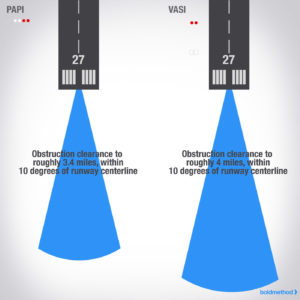By Swayne Martin – Boldmethod – Just light runway markings, runway lighting is spaced at defined intervals. Here’s how they’re spaced, and how these lights can make your next night flight safer.
Colors Found In Runway Edge Lighting
According to the FAA’s most recent Airfield Standardspublication, there are approximately 9 color combinations of lighting you’ll find around the edges of runways.

Runway Edge Light Spacing and Color
Both High Intensity Runway Lights (HIRLs) and Medium Intensity Runway Lights (MIRLs) require a maximum spacing of 200 feet between each runway edge light. For runways with intersecting taxiways or other runways, the maximum gap cannot exceed 400 feet. Additionally, the runway edge lights must be 2 to 10 feet offset from the full-strength paved runway edge.
Runway edge lights are white, until you start getting close to the departure end of the runway. On instrument runways, edge lights are yellow on the last 2,000′, or half the runway length, whichever is less. This forms a caution zone for landing on instrument runways at night. Keep in mind, however, that if you’re not landing on an instrument runway, the edge lights are white all the way to the end of the runway.

Runway Centerline Lighting and Color
Runway centerline lights and touchdown zone lights are required for CAT II and CAT III runways, and for CAT I runways used for landing operations below 2,400 ft RVR. Runway centerline lights are also required on runways used for takeoff operations below 1,600 ft RVR unless specifically approved by the FAA in an airline operator’s specification for that runway.
Runway centerline lights are spaced at 50 feet apart. Just like runway centerline markings, knowing this distance can help you perfect landings at night and ensure you don’t float too far. The line of runway centerline lights may be uniformly offset laterally to the same side of the physical runway centerline by a maximum of 2.5 feet.
When viewed from the landing threshold, runway centerline lights are white until the last 3,000 feet, where they begin to alternate red and white for 2,000 feet and eventually solid red for the final 1,000 feet.

Approach Lighting
Whether you’re VFR or IFR, approach lights can help you identify and line up with the runway at night.
Beyond that, approach lights help instrument pilots transition from IMC to VMC conditions. When you’re flying an instrument approach, if you can see the white approach light system and nothing else, you can descend down to 100′ above touchdown zone elevation, regardless of the type of approach you’re flying (even if it’s a non-precision approach). But at the 100′ point, you need other visual references to descend lower. Here are some examples of approach light systems that get you down to 100′ above the touchdown zone.

VASI and PAPI Lights
The Visual Approach Slope Indicator(VASI) is a system of lights arranged to provide visual descent guidance information during the approach to a runway for VFR and IFR pilots. These lights are visible from 3-5 miles during the day and up to 20 miles or more at night. The visual glide path of the VASI provides safe obstruction clearance within plus or minus 10 degrees of the extended runway centerline and to 4 NM from the runway threshold.
If you see two red lights over two white lights, you’re on glide path.Although normal glide path angles are 3 degrees, VASI lights at some airports may be as high as 4.5 degrees to give proper obstacle clearance.
The Precision Approach Path Indicator(PAPI) is another very common visual glide path indicator light. PAPIs use lights similar to the VASI, but are installed in a single row of either two or four light units. These lights are visible from about 5 miles during the day and up to 20 miles at night.
The visual glide path of the PAPI typically provides safe obstruction clearance within plus or minus 10 degrees of the extended runway centerline and to 3.4 NM from the runway threshold.
Two white lights and two red lights mean you’re on the established glide path on a PAPI.

Using Runway Lights To Make Your Flight Safer
Flying at night is challenging, but understanding the runway lighting system for your airport is a key to staying safe. Use the approach, visual glide path and runway lights at your airport, and you’ll stay on-glide and clear of obstructions all the way to touchdown.









